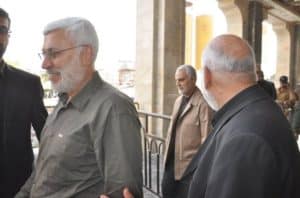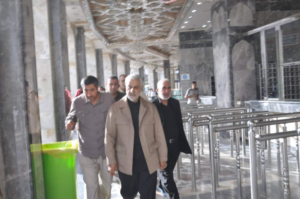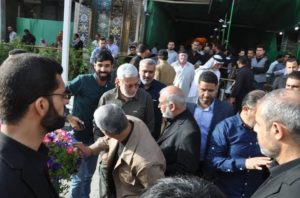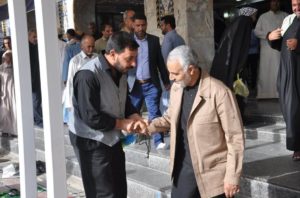
Soleimani and Muhandis
Yesterday, photos emerged on social media of Qassem Soleimani, the chief of the Islamic Revolutionary Guard Corps Qods Force, on a pilgrimage during a holy period in Ramadan to the shrine of Imam Hussein in Karbala, Iraq. Soleimani was photographed next to his deputy Abu Mahdi al Muhandis, the operations commander of the Iraqi Popular Mobilization Force (PMF), which was enshrined into a legal and separate military corps last year, thus technically making Muhandis a government official.
The US has designated both Soleimani and Muhandis as terrorists. A United Nations travel ban applies to the Iranian general until 2020.
Earlier this week, Iranian media posted photos of Soleimani in Syria allegedly by the border area with Iraq. He was photographed next to Afghan Fatemiyoun Division forces. Late last month, Soleimani was spotted with Iraqi militias in northwestern Iraq close to the Syrian border, according to the media.
Answering directly to Supreme Leader Ali Khamenei, Soleimani is in charge of Tehran’s Iraq and Syria portfolios.
Soleimani has signaled his plan of intimidating the US in southeastern Syria. In the past month, the US military has struck pro-regime forces including Iranian-backed militias three times and has downed an Iranian Shahed-129 drone inside the US deconfliction zone of At Tanf. On Wednesday, the spokesman of the Iraqi Harakat al Nujaba – which answers to Soleimani – threatened the US over potential military action against its forces. “In the case of any foolishness, we will target America’s interests anywhere in the region,” he said, then accusing the US of conspiring to disrupt operations by the Iraqi and Syrian border. The militia this week announced deployment to the southeastern Syrian front and plans to advance toward the Albukamal-Qaim border crossing further to the north. Harakat al Nujaba’s threat follows Lebanese Hezbollah’s vague threat last week over the US crossing “red lines” in Syria, which was issued a day following the June 6 US airstrike against pro-regime forces.
Soleimani is overseeing sensitive operations to gain territory in the Iraq and Syria border area as the Islamic State crumbles and links Iranian-backed militias, thus securing a supply route between Iraq and Syria. Iran used the land route to supply the Assad regime between 2011 and late 2012, when Syrian rebels shut it down. Iran afterwards turned to aerial supply to transfer weapons and material to the Levant. In Iraq, the PMF last month reached the border with Syria in the northwestern countryside and is moving southward toward the Albukamal-Qaim border crossing. The PMF reached the border town of Ba’aj this week, and commanders told The Guardian they are exploring pathways to create a supply line from there to the town of Deir Ezzor in Syria. Meanwhile, pro-regime forces in Syria have launched offensives in southern and central Syria. They seek to reach the besieged Deir Ezzor, capture a border crossing into Iraq and deny territory to both the US and US-backed forces.
If they are able to secure a viable border crossing between Iraq and Syria – and that is a big if at this time – it would complement Iran’s air bridge to Syria. Although achieving and holding a supply route faces significant obstacles, such as potential US-backed advancement into Deir Ezzor and an area laden with hostile insurgents.



Are you a dedicated reader of FDD's Long War Journal? Has our research benefitted you or your team over the years? Support our independent reporting and analysis today by considering a one-time or monthly donation. Thanks for reading! You can make a tax-deductible donation here.








2 Comments
This guy is racking up the frequent flyer miles.
What a double jack-pot that would be eh? Both have dues to be paid. I understand that from the outside looking in, most (like myself) wonder how these two still walk this earth. Only the powers that be can answer. But way too much American blood is covering these two” little Hitlers”. Every day that rolls by is an insult to human decency. Enough said.